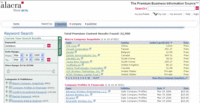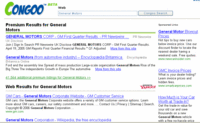Alacra Launches Ajax Version of Alacra Store
![]() A number of my recent posts have showcased products developed using an Ajax approach. Since I’m a believer in practicing what I preach, I’m pleased to note that this week, Alacra has unveiled an ajax-based version of the Alacra Store.
A number of my recent posts have showcased products developed using an Ajax approach. Since I’m a believer in practicing what I preach, I’m pleased to note that this week, Alacra has unveiled an ajax-based version of the Alacra Store.
Ajax, short for Asynchronous Javascript and XML, allows web-based applications to function more like traditional software application. Specifically, rather than redrawing an entire page every time a screen element changes, ajax allows you to refresh specific sections of a page, leaving the rest of the page intact. While that may not sound like much, it completely changes the user experience.
 To see how different ajax-based applications are, take a look at the new Alacra Store. When you perform a keyword search (wireless, for example), the results are displayed in seven content panels, each displaying one form of content related to that search (market research, credit & investment research, news, etc). Until this release, any change in your search would require a full page refresh.
To see how different ajax-based applications are, take a look at the new Alacra Store. When you perform a keyword search (wireless, for example), the results are displayed in seven content panels, each displaying one form of content related to that search (market research, credit & investment research, news, etc). Until this release, any change in your search would require a full page refresh.
Now, with the ajax version, individual panels are updated without reloading the page. For example, using the wireless search, uncheck the Company Profiles & Financials panel. All the other panels remain active, while that panel closes.
 Next, let’s lower the maximum price range of any report to $1,000, using the slider bar on the left. You’ll see all the panels refresh (once the "searching" boxes clear), with the results of each available when they are ready, rather than waiting for all seven to update.
Next, let’s lower the maximum price range of any report to $1,000, using the slider bar on the left. You’ll see all the panels refresh (once the "searching" boxes clear), with the results of each available when they are ready, rather than waiting for all seven to update.
For another example, click on the radio button to turn on KWIC (keyword in context). Those content sources that offer KWIC will redisplay in KWIC mode, while the others remain constant.
These changes are modest. They don’t enable functionality that wasn’t available before ajax. However, they make much of that functionality usable. The slider bar that allows you to set price ranges is a very practical way to navigate the results. The traditional way to do that might have been to allow the user to put in minimums and maximums, then refresh the page. While that approach might work if the user knows they have a $100 cap on any research they can buy, it’s not practical for someone who might want to browse what’s available at the low-end, then gradually increase their threshold until they find what they need. The interactivity enabled by ajax can have a great impact on overall usability.
Ajax is still a fairly new approach and developers are just starting to test the boundaries of what this interactivity will allow them to do. Microsoft has just announced its ajax-based capabilities, Microsoft Atlas, which is sure to increase the use of this approach. In the months to come we should begin to see more and more complex functionality move to the web.
















